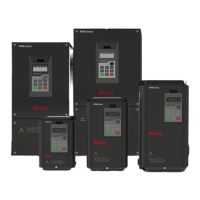Table 6-1 Restarting conditions
Table 6-1 shows the drive’s action under different
conditions. “0” means the drive enter ready status
and “1” means the drive start operation
automatically.
Note:
1. A1.10 is only enable in 2-wire mode.
2. If there is a stopping command, the drive will
stop first.
3. When the function of restart after power failure
is enabled, the drive will start in the way of
speed tracking mode after power on if it is not
switched off totally (that is, the motor still runs
and drive’s LED displays “P.OFF”). It will start in
the starting mode defined in A1.00 after power
on if it is switched off totally (LED turns off).
A1.12 Anti-reverse running function
0: Disabled
1: Enabled
Note:
This function is effective in all control modes.
A1.13 Delay time of run reverse/
forward
The delay time is the transition time at zero
frequency when the drive switching its running
direction as shown
in Fig. 6-6 as t
1
.
Fig.6-6 Delay time from reverse running to forward
running or from forward running to reverse running
A1.14 Switch mode of run reverse/forward
0:Switch when pass 0Hz
1:Switch when pass starting frequency
A1.15 Detecting frequency of
stop
A1.16 Action voltage of
braking unit
4T: 650~750【720】
2S: 320~380【380】
0:Dynamic braking is disabled
1:Dynamic braking is enabled
Note:
This parameter must be set correctly according to
the actual conditions, otherwise the control
performance may be affected.
A1.18 Ratio of working time of
braking unit to drive’s total working
time
This function is effective for the drive with built-in
braking resistor.
Note:
Resistance and power of the braking resistor must
be taken into consideration when setting this
parameters.
A1.19 Restart mode selection for
power failure
0: Current search mode
It is only valid in V/F control. If it is not V/F control, it
will run mode 1.
1: Vector tracing mode
It starts in vector control mode.
2: Define by A1.00
It will start according to starting mode set in A1.00.
6.3 Group A2
A2.00 Auxiliary reference frequency
selector
0:No auxiliary reference frequency

